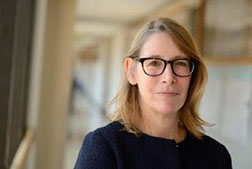Neural Representations of Natural Self-Motion: Implications for Perception & Action
Kathleen E. Cullen
Professor, Department of Biomedical Engineering
Johns Hopkins University
Wed, February 5, 2020 - 4:00 PM
Karl Herzfeld Auditorium of Hannan Hall - Rm 108

A fundamental question in neuroscience is how does the brain compute accurate estimates of our self-motion relative to the world and our orientation relative to gravity in everyday life. In this talk, I will describe recent findings from my laboratory’s research that have addressed this question and provided new insight into how vestibular pathways encode self-motion information to ensure accurate perception and motor control.
First, we have recently examined the statistics of natural self-motion signals experienced by mice, monkeys, and humans, and then explored the neural coding strategies used by early vestibular pathways. Focusing on the relationships between neural variability, detection thresholds, and information transmission, our findings have revealed that two distinct sensory channels represent vestibular information at the level of the vestibular periphery. Notably, more regularly discharging afferents have better detection thresholds and use rate coding, while more irregular afferents take advantage of precise spike timing (i.e, temporal coding) and are better optimized for processing natural vestibular stimuli.
Our research has also established that the neurons at the first central stage of vestibular processing are substantially less sensitive to active motion. Notably, this ability to distinguish between active and passive motion is not a general feature of early vestibular processing, but is instead a characteristic of a distinct group of neurons known to contribute to postural control and spatial orientation. Our most recent studies further indicate that cerebellum builds a dynamic prediction (e.g., internal model) of the sensory consequences of self-motion during active behaviors, which in turn enables the preferential encoding of unexpected motion to ensure postural and perceptual stability. Moreover, when unexpected vestibular inputs become persistent during active motion, indicating that this mechanism is rapidly updated to re-enable the vital distinction between active and passive motion to ensure the maintenance of posture. Finally, our recent findings have established that posterior thalamocortical vestibular pathway even more selectively encode unexpected motion, thereby providing a neural correlate for ensuring perceptual stability during active versus externally generated motion.
Refreshments served at 3:45 PM
If you have any questions about the Colloquium Series or would like to make a donation please contact the Physics Department, cua-physics@cua.edu or (202) 319-5315.
